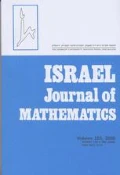Abstract
Let Γ be a finitely generated non-elementary Fuchsian group, and let μ be a probability measure with finite support on Γ such that supp μ generates Γ as a semigroup. If Γ contains no parabolic elements we show that for all but a small number of co-compact Γ, the Martin boundaryM of the random walk on Γ with distribution μ can be identified with the limit set Λ of Γ. If Γ has cusps, we prove that Γ can be deformed into a group Γ', abstractly isomorphic to Γ, such thatM can be identified with Λ', the limit set of Γ'. Our method uses the identification of Λ with a certain set of infinite reduced words in the generators of Γ described in [15]. The harmonic measure ν (ν is the hitting distribution of random paths in Γ on Λ) is a Gibbs measure on this space of infinite words, and the Poisson boundary of Γ, μ can be identified with Λ, ν.
Similar content being viewed by others
References
G. Birkhoff,Extensions of Jentzsch's theorem, Trans. Am. Math. Soc.85 (1957), 219–227.
R. Bowen,Equilibrium states and the ergodic theory of Anosov diffeomorphisms, Springer Lecture Notes470 (1975).
Y. Derriennic,Marche aléatoire sur le groupe libre et frontière de Martin, Z. Wahrscheinlichkeitstheor. Verw. Geb.32 (1975), 261–276.
Y. Derriennic and Y. Guivarc'h,Théorème de renouvellement pour les groupes nonmoyennables, C.R. Acad. Sci. Paris277 (1973), 613–615.
E. B. Dynkin and M. B. Malyutov,Random walks on groups with a finite number of generators, Sov. Math. Dokl.2 (1961), 399–402.
E. B. Dynkin and A. A. Yushkevich,Markov Processes: Theorems and Problems, New York, Plenum Press, 1969.
W. Floyd,Group completions and limit sets of Kleinian groups, Invent. Math.57 (1980), 205–218.
L. R. Ford,Automorphic Functions, McGraw-Hill, New York, 1929.
H. Furstenberg,Non-commuting random products, Trans. Am. Math. Soc.108 (1963), 377–428.
H. Furstenberg,Random walks and discrete subgroups of Lie groups, Advances in Probability and Related Topics, Vol. 1, Dekker, New York, 1971, pp. 1–63.
J. Kemeny, J. Snell and A. Knapp,Denumerable Markov Chains, Van Nostrand, Amsterdam, 1966.
B. Maskit,On Poincare's theorem for fundamental polygons, Adv. Math.7 (1971), 219–230.
D. Ruelle,Characteristic exponents and invariant manifolds in Hilbert space, I.H.E.S., preprint, 1980.
E. Seneta,Non-Negative Matrices, Allen and Unwin, London, 1973.
C. Series,The infinite word problem and limit sets in Fuchsian groups, J. Ergodic Theory and Dynamical Systems1 (1981), 337–360.
V. Titulabin,On limit theorems for the products of random matrices, Theory Probab. and its Appl.10 (1965), 15–27.
Author information
Authors and Affiliations
Rights and permissions
About this article
Cite this article
Series, C. Martin boundaries of random walks on Fuchsian groups. Israel J. Math. 44, 221–242 (1983). https://doi.org/10.1007/BF02760973
Received:
Revised:
Issue Date:
DOI: https://doi.org/10.1007/BF02760973



